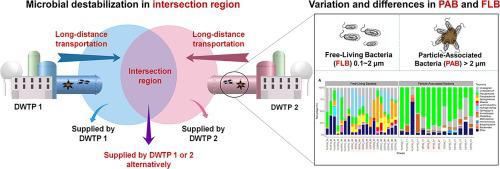Environment International ( IF 11.8 ) Pub Date : 2021-04-16 , DOI: 10.1016/j.envint.2021.106552 Kaiqin Bian 1 , Chen Wang 1 , Shuyu Jia 1 , Peng Shi 1 , Huaicheng Zhang 1 , Lin Ye 1 , Qing Zhou 1 , Aimin Li 1

|
With the expansion of cities, the deterioration of drinking water quality undergoing complex and long-distance distribution is gaining increasing attention. However, spatial variations between free-living bacteria (FLB) and particle-associated bacteria (PAB) in chlorinated drinking water distribution systems (DWDSs) have not been fully explored, especially in complex water supply areas with multiple interconnected DWDSs. To fill this gap, this study utilized 16S rRNA approaches to characterize the spatial patterns of FLB and PAB in DWDSs with intersection regions. Based on distance-decay analysis, transportation distance is a potential driver of bacterial variation for both FLB (Pearson’s r = −0.476, p < 0.01) and PAB. (Pearson’s r = −0.352, p < 0.01). Moreover, the influence of transportation distance was further confirmed by a 1.20–99.45% decline in microbial contribution to the source of FLB and PAB communities in pipe water along the transportation pipelines. Meanwhile, significant difference (PERMANOVA, R2 = 0.14, p < 0.01) was found between FLB and PAB in DWDSs. Average proportions of Pseudomonas spp. were 59.84% and 45.59% for the PAB and intersection regions based on the 16S rRNA results, respectively, suggesting that PAB are potential reservoirs for high-risk bacteria, and a greater microbial risk may exist in intersection regions. In summary, transportation distance and pipeline intersection exerted significant impacts on the FLB and PAB in DWDSs. Therefore, precautionary strategies for controlling microbial risks that consider different microbial components and intersection regions in long-distance and multi-plant DWDSs should be implemented.
中文翻译:

由两个处理厂提供的氯化饮用水分配系统中细菌群落的空间动态:自由生活和与颗粒相关的细菌的整体研究
随着城市的扩大,饮用水质量的复杂化和长距离分配日益引起人们的关注。但是,尚未充分探索氯化饮用水分配系统(DWDS)中自由生存细菌(FLB)和颗粒相关细菌(PAB)之间的空间差异,尤其是在具有多个相互连接的DWDS的复杂供水区域中。为了填补这一空白,本研究利用16S rRNA方法来表征具有交叉区域的DWDS中FLB和PAB的空间模式。基于距离衰减分析,运输距离是FLB(Pearson r = -0.476,p <0.01)和PAB细菌变化的潜在驱动因素。(皮尔逊的r = −0.352,p <0.01)。此外,沿运输管道的管道水中微生物对FLB和PAB群落来源的贡献下降了1.20–99.45%,进一步证实了运输距离的影响。同时, 在DWDS中,FLB和PAB之间存在显着差异(PERMANOVA,R 2 = 0.14,p <0.01)。假单胞菌的平均比例spp。根据16S rRNA结果,PAB和交叉区域的PAB分别为59.84%和45.59%,这表明PAB是高风险细菌的潜在库,交叉区域可能存在更大的微生物风险。总之,运输距离和管道交叉点对DWDS中的FLB和PAB产生了重大影响。因此,应采取预防策略,以控制考虑到长距离和多工厂DWDS中不同微生物成分和交叉区域的微生物风险。


























 京公网安备 11010802027423号
京公网安备 11010802027423号